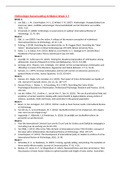Victimologie Samenvatting Artikelen Week 1-7
Week 1:
1. van Dijk, J. J. M., Groenhuijsen, M. S., & Winkel, F. W. (2007). Victimologie: Voorgeschiedenis en
stand van zaken. Justitiële verkenningen: Documentatieblad van het Ministerie van Justitie,
33(3), 9-29.
2. O’Connell, M. (2008). Victimology: A social science in waiting? International Review of
Victimology, 15, 91-104.
Week 2:
1. Dijk, J.J. van (2009). Free the victim: A critique of the western conception of victimhood.
International Review of Victimology, 16 (1), 1-33.
2. Fohring, S (2018). Revisiting the non-ideal victim. In: M. Duggan (Red.). Revisiting the “Ideal
Victim”: Developments in Critical Victimology (pp.195-209). Bristol University Press.
3. Hafer, C.L. & Sutton, R.M. (2016). Belief in a Just World. In: C. Sabbagh & M. Schmitt (Red.)
Handbook of Social Justice Theory and Research (pp.145-160).
Week 3:
1. Averdijk, M., & Bernasco W. (2015). Testing the situational explanation of victimisation among
adolescents. Journal of Research in Crime and Delinquency, 52 (2), 151-180.
2. Jennings, W.G., Piquero, A.R., & Reingle, J.M. (2012). On the overlap between victimisation and
offending: A review of the literature. Aggression and Violent Behavior, 17 (1), 16-26.
3. Schreck, C.J. (1999). Criminal victimisation and low self-control: An extension and test of a
general theory of crime. Justice Quarterly, 16 (3), 633-654.
Week 4:
1. Hanson, R.F., Begle, A.M. & Hubel, G.S. (2010). The Impact of Crime Victimisation on Quality of
Life. Journal of Traumatic Stress, Vol. 23, (2), 189–197
2. Hanson Frieze, I., Hymer, S., & Greenberg, M.S. (1987). Describing the Crime Victim:
Psychological Reactions to Victimization. Professional Psychology: Research and Practice, 18 (4),
299-315.
3. van der Velden, P.G., Contino, C., van de Ven, P., Das, M. (2021). The use of professional help and
predictors of unmet needs for dealing with mental health to legal problems among victims of
violence, accidents, theft and threat, and nonvictims in the general population.
Week 5:
1. Boom, A. ten, & Kuijpers, K.F. (2012). Victims’ needs as basic human needs. International Review
of Victimology.
2. Van der Aa, S., & Groenhuijsen, M. S. (2012). Slachtofferrechten in het strafproces: drie stapjes
naar voren en een stapje terug?
3. Augusteijn, F., Bijleveld, C.& Pemberton, A. (2022). De praktijk van slachtofferrechten: de
perceptie van professionals.
Week 6:
1. How the International Criminal Court and its Trust Fund for Victims work (bekijk de webpagina’s
met uitleg over de werking van de ICC-CPI).
2. Van Wijk, J. (2013). Who is the ‘little old lady’ of international crimes? Nils Christie’s concept of
the ideal victim reinterpreted. International Review of Victimology, 19(2), 159-179.
3. Groenhuijsen, M. (2014). The development of international policy in relation to victims of crime.
International Review of Victimology, 20(1), 31-48.
Week 7:
1. Scheufele, D. A., & Tewksbury, D. (2007). Framing, agenda setting, and priming: The evolution of
three media effects models. Journal of Communication, 57 (1), 9-20.
2. Boukes, M., Jones, N. P., & Vliegenthart, R. (2022). Newsworthiness and story prominence: How
the presence of news factors relates to upfront position and length of news stories. Journalism,




